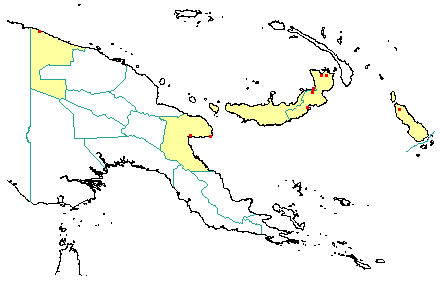
in PNGplants database
PNGTreesKey – Palaquium amboinense Burck |
Barry Conn (NSW) & Kipiro Damas (LAE).
Guide to trees of Papua New Guinea
Copyright held by the authors, National Herbarium of New South Wales, and Papua New Guinea National Herbarium
Annales du Jardin Botanique de Buitenzorg Vol. 5: 37 (1886)
Other Literature: P. van Royen, Blumea 589 (1960)
Family: Sapotaceae
Dicotyledon
Timber Group: Minor hardwood Tradename: Pencil Cedar
Field Characters: Emergent tree or Large canopy tree (up to 40 m high); Bole cylindrical (up to c. 60 cm diam.); straight (bole up to c. 25 m long); buttresses buttresses present (buttresses up to 2 m high) or buttresses absent; spines spines absent; aerial roots aerial roots absent; stilt roots stilt roots absent; Bark red or brown, rough, pustular, lenticels rounded/swelling (with lenticels orange-brown); less than 25 mm thick, 20.0-25.0; bark blaze consisting of one layer; faintly to non-aromatic; outer blaze dark red, markings absent; inner blaze dark red, markings absent; bark exudate (sap) present, white/milky, flowing or not readily flowing (spotty), colour not changing on exposure to air, sticky; terminal buds not enclosed by leaves.
Indumentum: Complex hairs absent; stinging hairs absent; mature twig indumentum (hairs) present when young or absent, hairs dense to sparse.
Leaves: Leaves slightly clustered at end of branches or spaced along branches, spiral (leaves occurring singly at a node and arranged spirally up the branchlet), simple (a leaf composed of a single blade); petiole present, not winged or winged (slightly (lamina shortly decurrent), attached to base of leaf blade, not swollen; leaves broadest above middle or broadest at or near middle, (5.0-) 7.0-16.0 cm, 2.5-5.5 cm; symmetric, entire, not dissected or lobed, acuminate, venation pinnate, secondary veins open, prominent, intramarginal veins absent; leaves lower surface pale green, upper surface green, indumentum (hairs) absent; absent; domatia absent; stipules present, free, laterally placed, not encircling the twig, hair-like (long and thin - acicular), not fringed, small (1-2.5 mm long), not persistent.
Flowers: Inflorescence axillary, flowers single or flowers arising from a single point (2-6-flowered), cones absent; flowers bisexual, stalked, flowers with many planes of symmetry, 4.0-6.0 mm long, diameter small (up to10 mm diam.) (c. 5 mm diam.); perianth present, with distinct sepals and petals whorls, inner perianth white, pale yellow, pale green, or cream-coloured; 6, some or partly joined; stamens 12, present, free of each other, joined to the perianth; ovary superior, carpels joined (when more than one), locules 6 (deeply 6-lobed); styles solitary, 1.
Fruits: Infrutescence single or arising from single point, fruit 36.0-50.0 mm long, red or brown, not spiny, fleshy, simple, indehiscent, berry; seeds 1, to about 5 mm long (3.5-5 mm long), not winged, broad (as wide as long) (pointed at each end), seed 1-10 mm diam. (c. 3 mm diam.).
Distribution: West Sepik, Morobe, New Britain & Bougainville.
 | Botanical records in PNGplants database |